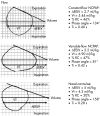Influence of three nasal continuous positive airway pressure devices on breathing pattern in preterm infants
- PMID: 17088340
- PMCID: PMC2675435
- DOI: 10.1136/adc.2006.103762
Influence of three nasal continuous positive airway pressure devices on breathing pattern in preterm infants
Abstract
The pattern of breathing was studied in 13 premature newborns treated by variable-flow Nasal Continuous Positive Airway Pressure (NCPAP), conventional NCPAP, and nasal cannulae. Compared to constant-flow NCPAP and nasal cannulae, the variable-flow NCPAP increases tidal volume and improves thoraco-abdominal synchrony, suggesting that variable-flow NCPAP provides more effective ventilatory support than conventional NCPAP or nasal cannulae.
Conflict of interest statement
Competing interests: None.
References
Publication types
MeSH terms
LinkOut - more resources
Full Text Sources
Medical





